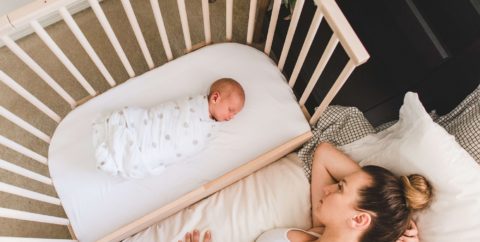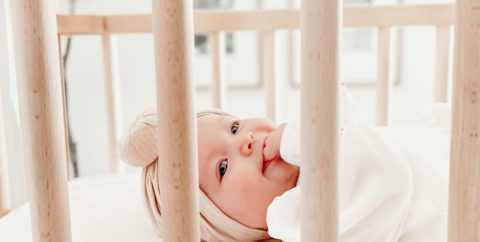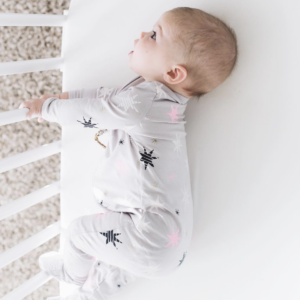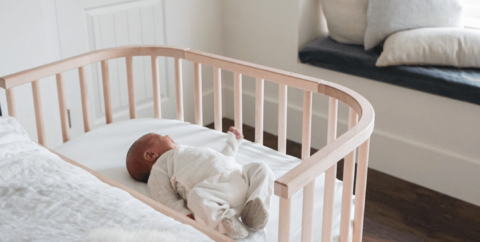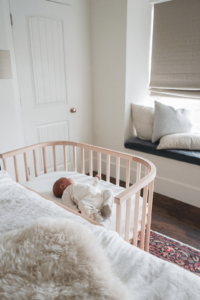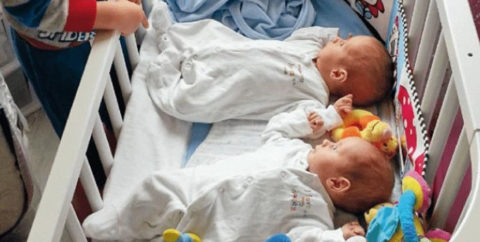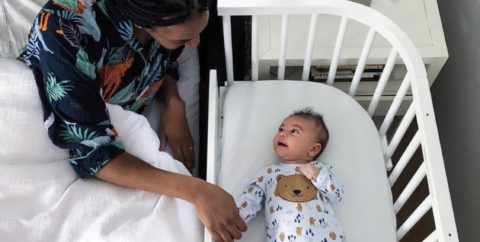bedside co sleeper
If you search for “co sleeping” in the dictionary, you’ll probably find a definition that looks like this one (courtesy of Merriam-Webster): co sleeping is “the practice of sleeping in the same bed or close by in the same room with one’s child.”
Seems simple enough to understand, doesn’t it?
But in truth, this definition doesn’t even begin to answer the question What does co sleeping mean? 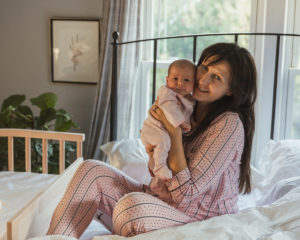
Because this definition groups three very different sleeping practices—bed sharing, room sharing, and co sleeping—under the same “co sleeping” umbrella.
To get a more accurate answer to the question What does co sleeping mean?, it’s important to understand the differences between these three sleeping practices. (Because yep — they’re all different and all come with differing degrees of safety attached.)
Once you understand the pros and cons associated with each, it will become easier to decide whether enjoying the benefits of co sleeping is the right next step for your family.
Co Sleeping, Bed Sharing, and Room Sharing: How Are They Different?
“Co sleeping” is often used as the catch-all term for describing the experience of sleeping close to your baby.
However, co sleeping with the help of a safe bedside co sleeper is a very different experience than practicing more general room sharing or bed sharing. When people use the term “co sleeping,” they’re likely referring to one of two fairly different sleep practices: room sharing or bed sharing.
Because it can be easy for all this different terminology to get kind of (or very!) confusing, here’s a quick breakdown of the similarities and differences:
“Room sharing” refers to instances when baby is invited to sleep in the same room as their parents—but on a different sleeping surface. When parents choose to sleep in their own bed with their baby catching Z’s in a crib or baby bassinet nearby, they are participating in room sharing. 
“Bed sharing” refers to the practice of not only inviting your baby or child into your room, but into your bed as well. When bed sharing, children and parents sleep together on the same mattress and share bedding.
So How Are They Different?
While a bed sharing setup helps parents take advantage of many co sleeping benefits (like feeling more bonded with baby by sleeping so close by), it can be difficult to guarantee safe co sleeping positions when you’re sharing a bed.
That’s because the oh-so-soft mattresses and bedding that parents often prefer are not the safest choice for babies, especially when the baby is still so young that they are not easily able to untangle themselves if they’re accidentally covered by bedding.
Parents who are unsure about whether bed sharing is the right practice for them often turn to bedside co sleepers (also called a bedside crib, along with a few other names) as a perfect solution.
Bedside co sleepers offer a blend of safety and closeness while giving both you and your baby a perfect made-just-for-you place to enjoy the night and sleep tight.
So What’s the Deal with Bedside Co Sleepers and Bedside Cribs?
When you practice co-sleeping with the right bedside crib, you’re able to enjoy all the benefits of bed-sharing, without the safety concerns that sharing a bed with your baby can bring.
This type of safe co-sleeping is sometimes referred to as separate-surface co-sleeping, and involves sleeping on your own mattress with your baby safely cuddled in a bedside baby co sleeper, baby bassinet, or crib pushed against your bedside. 
By using safe co sleeping solutions like the babybay bedside co sleeper, you get to enjoy the plush and comfy bedding and mattress you prefer, while your baby enjoys a made-just-for-them crib mattress and sleeping space all their own.
Which means you’ll be able to co sleep soundly, knowing that your baby is feeling supported by a firm mattress that is perfect for their growing body, while being comforted by the feeling of having you no more than an arm’s reach away.
Co Sleeping Benefits: What Positive Experiences Should You Expect?
The connection between baby and mother doesn’t end the moment that baby is delivered. In fact, experts agree that babies and their caregivers remain physiologically connected to each other in complicated but powerful ways following birth.
As anthropologist James J. McKenna found, babies who sleep close to their caregivers wake up more frequently, but those wakings are also less disruptive than when they are catching Z’s further away.
Parents who are sleeping beside their baby are very aware of and receptive towards these moments of wakefulness, which and will often take a moment to offer touch, check for crisis, hug, or otherwise support their baby in quick but loving ways.
These loving touches go a long way in helping baby settle their stress levels and breathe easy, which positively supports their psychological and physical growth.
But beyond these moments of nurturing, co sleeping makes nighttime nursing easier, and helps the whole family get longer, more restful nights of sleep by making it simple to know when baby needs support and offer the proper care. (Which is good news, because if there’s one thing that all parents could use more of—it’s sleep!)
Separate-Surface Co-Sleeping: What’s the Best Sleeper to Use?
There are many different co-sleepers out there that can be used for separate-surface co-sleeping, but not all of them are gold-star status when it comes to ease, safety, and comfort. 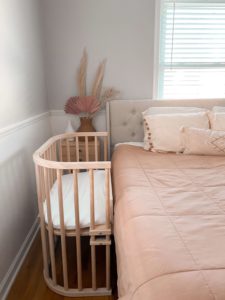
The babybay bedside co sleeper is specially engineered to fit snugly against your own bed, meaning you don’t even have to leave your mattress or reach over awkward crib bars to care for your baby during the night.
And because babybay considers your baby’s safety and comfort as Priority #1, you can be confident that baby will feel secure and supported when cuddled into the half-moon shape designed to mimic the warm embrace of a hug.
Meaning that your baby will feel more than happy to settle into dreamland with you by their side, while you catch some much-needed Z’s of your own—knowing that you’ve found the answers to What does co-sleeping mean? and have a sleeping solution that delivers big co sleeping benefits while delivering peace of mind.
There’s one important thing you should always remember when deciding how co sleeping fits into your family’s nighttime routine: only you know what works best for you and your baby.

But as you research the many benefits of co sleeping and get excited for the nights of deeper bonding ahead, you might come across fellow parents claiming that co sleeping might not be the best option for children under a certain age.
Which might have you wondering—why is co sleeping bad for newborns?
Here’s the simple answer: when done safely, co sleeping isn’t bad at all!
In fact, when anthropologist John Whiting surveyed 186 cultures, he discovered that almost 70% of children sleeping and growing strong around the world slept in the company of others.
While 70% of families around the globe and much research has shown that co sleeping offers many benefits (Easier nighttime nursing, better rest for the whole family, and quicker crisis response? Yes, please!) there’s a little trick of naming that’s causing some confusion about co sleeping.
The truth is that “bed sharing” is not the same as other, safe co sleeping practices.
While the babybay bedside co sleeper has been safety-certified by ASTM International, TÜV, and Confidence in Textiles, bed sharing (when a baby sleeps in the same bed as the parent/s) does not come backed by the same safety guarantee.
Despite this big safety difference, these two terms (“bed sharing” and “co sleeping”) are often used interchangeably.
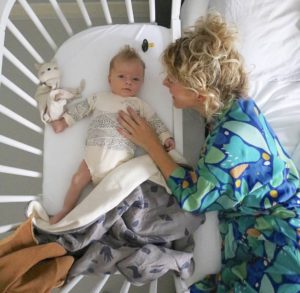 As any parent who enjoys sleeping an arm’s reach away from their baby with the help of a bedside co-sleeper will tell you, there are ways to get stress-free, worry-less, and benefit-filled nights of rest while co sleeping.
As any parent who enjoys sleeping an arm’s reach away from their baby with the help of a bedside co-sleeper will tell you, there are ways to get stress-free, worry-less, and benefit-filled nights of rest while co sleeping.
You just need to choose the right co sleeping method.
What Age Is Co Sleeping Safe? Is My Newborn Baby Too Young?
The American Academy of Pediatrics recommends sleeping in the same room as your baby (or “room sharing”) for at least the first six months of baby’s life.
When you room share, you set up a separate space for baby to sleep beside your own bed. By giving them a firm mattress to sleep on that is all their own, you allow them to feel properly supported through the night, while still being close enough to respond quickly to anything they might need.
There’s a reason why so many parents recommend this approach. Depending on your child’s development, it can be dangerous to have your baby share space on the soft, plush, comfy, and pillowy bedding and mattress you love.
The truth is, your baby’s body is best supported by a firm space to rest. 
And though your baby will one day be a pro at untangling themselves from any blanket or pillow that comes their way, newborns are still not quite used to the art of getting themselves unwrapped or untangled from any fabric that covers them.
What’s why many experts suggest waiting to bed share until baby is old enough to easily get unstuck from any bedding they get tangled in.
However, with the help of a bedside co sleeper, you’ll be able to co sleep from the first night your baby is born–without having a single safety concern.
That’s because babybay bedside sleepers are specially engineered to give your baby the safe, firm, and far-from-your-blankets sleeping space they need to rest comfortably and securely all night long.
Which is why parents who are wondering why is co sleeping bad for newborn babies? need to understand that the how of co sleeping is important, especially when determining what age is co sleeping safe for your baby.
With the right safe co sleeping solution by your bedside, you can enjoy rest-filled nights and the other many benefits of co sleeping from the first day baby is brought home, while being fully confident that your baby is safe and comfortable in a bedside co sleeper made just for them.
What’s the Best Age to Transition from Co Sleeping?
As we said: no one knows your baby’s needs better than you.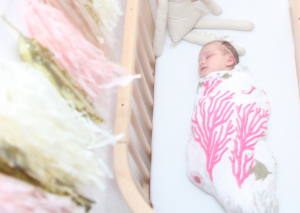
Though the best age to transition from co sleeping will eventually come, there’s no hard and fast rule of when this will be for you.
The best thing you can do is keep track of your baby’s developmental patterns, and know that there might be a time when baby’s sleep habits or your own needs make you feel ready to move baby to a separate crib or room of their own.
When that time eventually comes, just know that your baby will be well-prepared to take on the nighttime routine changes ahead.
And the next time you hear a fellow parent ask Why is co sleeping bad for newborn babies? just like you did, you’ll be able to tell them straight out…
It’s not! You just need the right safe co sleeping solution by your bedside.
Customize my babybay
For parents wondering when is co sleeping safe?, there are many factors that need to be considered. But the #1 most important one might not be quite what you think…
To know when the right time to start co sleeping with your little one might be, you first need to know the differences between the types of co sleeping that parents might choose to practice as a family.
Because as it turns out, there are many different sleep practices that often get grouped under the “co sleeping” umbrella.
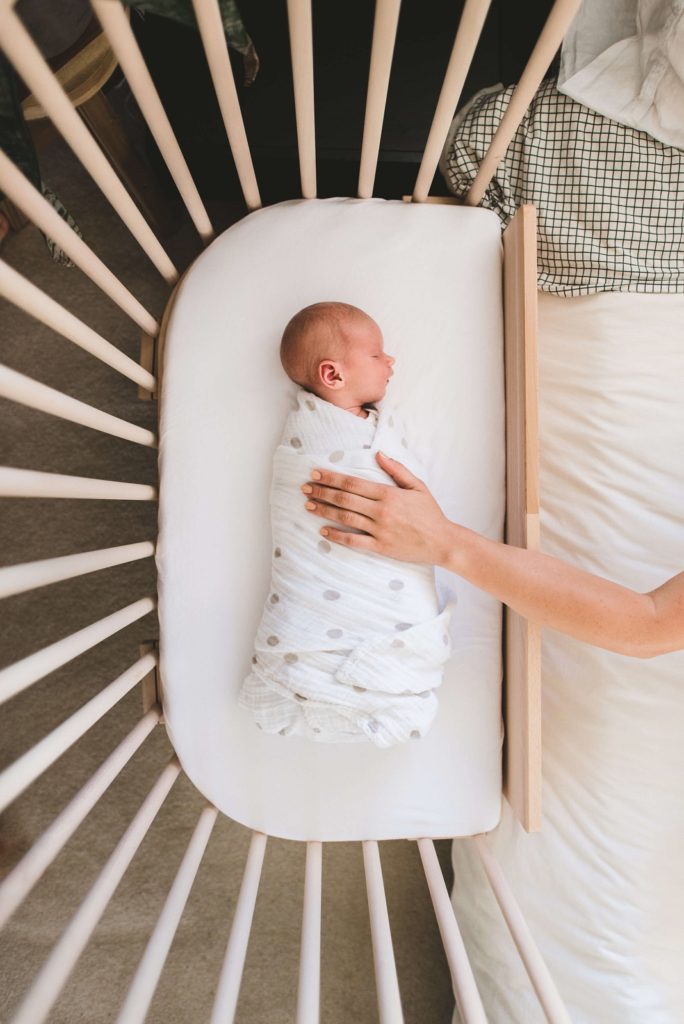
And while some—like enjoying the benefits of a bedside co sleeper—offer an ASTM, TÜV, and Confidence in Textiles certified-safe solution for helping baby catch some rest while sleeping by your side, other common co sleeping practices don’t offer the same safety guarantee.
“Bed sharing,” for example, references the practice of inviting a baby into your own bed to sleep during the night. Though bed sharing is often considered one form of co-sleeping, there are key safety differences between the two.
So let’s break down what those differences (and similarities!) happen to be…
Bed Sharing: What to Know About Safety and The Question When Is Co Sleeping Safe?
The American Academy of Pediatrics knows that keeping your baby close during the first year of their life carries a whole host of benefits (like making nighttime nursing a breeze and helping you easily respond to every crisis call).
That’s why they recommend room sharing with baby for at least the first 6 months of their life, and ideally through the first year.
But in the eyes of the AAP, room sharing is not the same as bed-sharing.
While bed-sharing with 6 month-old or younger babies can carry risks like concerns about comfy bedding, soft objects, or any other pillowy or quilted materials causing harm, room sharing does not create these same concerns.
When you room share, you offer baby the firm, made-just-for-them sleep space they need to feel comfortable, cozy, and safe all night long.

You get to enjoy the adult mattress and oh-so-plush bedding you’ve come to love, while giving baby a sleeping space all their own that is perfectly designed to support them and keep them safe.
Which is the kind of win-win that bed sharing does not always guarantee.
When Can You Start Room Sharing?
Because you’re sharing a space rather than sharing a bed, you can room share with baby from the first moment they come home from the hospital.
On the other hand, bed-sharing with 6 month-old or younger babies is not as easily recommended.
That’s because your baby has yet to learn the escape artist skills they need to untangle themselves from any soft fabrics that come their way. (Those escape artist skills will come one day! But not for a while down the road.)
That’s why many parents of young babies choose to confidently practice a form of co-sleeping that give baby a sleeping space that’s made just for them.
With a bedside co sleeper securely attached to your bed, this is the kind of confidence you get from the first day you bring your little one home from the hospital.
How to Co-Sleep Safely: Down to the Details
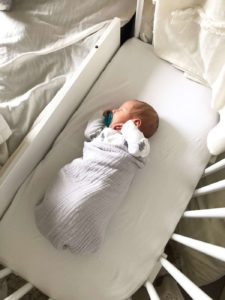
Luckily, it doesn’t have to be hard to co-sleep safely.
There are certain gold-star co sleeping practices that help you get stress-free nights of sound rest while supporting your baby’s body and mind.
Bedside sleepers deliver all the benefits of co sleeping like more bonding time with baby, easier nighttime nursing, and boosted support for baby’s healthy physical and mental growth. While also gifting you with peace of mind (which is one of the best gifts of all, can’t we agree?).
Bedside sleepers like the babybay attach snugly to the side of your own mattress, allowing you to sleep comfortably on the soft bedding you love while giving your baby a made-just-for-them sleeping space that properly supports their needs.
That means they can enjoy the firm mattress that’s safest for them—without you having to sacrifice any of your own sleep comfort.
The best part? Bedside co sleepers allow you to always be within arm’s reach of your baby all through the night. That means you’ll be able to soak up all the close-by-baby benefits of co sleeping, without a single moment of stress or worry.
When Is Co-Sleeping Safe with a Bedside Co-Sleeper?
The babybay bedside co sleeper has been lovingly designed to support your baby through nights of safe co sleeping as soon as they come home from the hospital.
That means that the babybay will be there to support all of your co-sleeping needs from the moment that your baby is born!
And when you feel it’s the best age to transition from co sleeping, you can be sure that your baby will be ready to get full nights of rest all on your own, with full confidence that you’re there to support them during every step of the way.
That’s why parents that wonder when is co sleeping safe? should keep this in mind: how you co-sleep matters when you’re trying to decide the right time to start.
[Get my babybay]
Is it feeling like time to encourage your baby to stop co-sleeping? Or to switch them over to a new set-up so they can catch their Z’s in a space all their own? Great! But does it also feel like a challenge to figure out how to transition from co-sleeping to crib?
Less great…but good thing we have you covered on that front!
Here’s the most important thing to remember as you start on your journey away from co-sleeping: every family is unique. And so is every co sleeping journey.
Though family, friends, or strangers online might swear by one method of transitioning from co-sleeping, that doesn’t mean that this is the right method for you.

As you make plans to transition from co-sleeping to crib, take into account your own needs. Also take into account how your baby’s personality might respond better—or worse!—to different possible methods.
Though there are many parent-loved approaches out there (from taking the gradual approach to stopping “cold turkey”), there’s one thing you should keep in mind no matter which strategy you choose…
Consistency is key.
Though there are sure to be a few bumps along the road or nights when things just don’t seem to go according to plan, keep at it!
Putting a plan in place and following it closely will help your baby quickly get used to their new nighttime routine.
Why It’s So Hard to Transition from Co-Sleeping to Crib
Have you ever suffered through a night of tossing and turning because you were in an unfamiliar place? Or lost plenty of good hours of rest because you were sleeping on a mattress that wasn’t your own?
It’s common for anyone (adults and babies alike!) to have a hard time sleeping when they’re getting used to a new sleeping environment. Or when they’re adjusting to new nighttime sounds.
Your baby has gotten used to the comfortable feeling of sleeping by your side. Suddenly moving across the room into a crib of their own—or moving into a whole new room of their own—is bound to create some confusion and discomfort during the transition stage.

But the more consistent you can be, the easier it will be for your baby to feel comfortable with the new routine you’re setting.
It’s important to hold strong! Even in the tempting moments when you’re faced with your baby’s discomfort and a night or two of lack of sleep.
By outlining your goals ahead of time and being clear on what method you’ve chosen and why you believe it’s the one that will best support your baby’s transition, you’ll be able to roll over all those bumps and help baby get used to their new routine in no time.
How Bedside Co-Sleepers Help Ease the Transition from Co-Sleeping to Crib
Luckily, families who have been co sleeping with the help of a bedside co sleeper like the babybay often have an easier time transitioning baby away from their bedside.
Because your baby is already familiar with the feel of their baby co-sleeper, they won’t have to get used to a new sleeping space. They’ll just have to get used to a new distance from you.
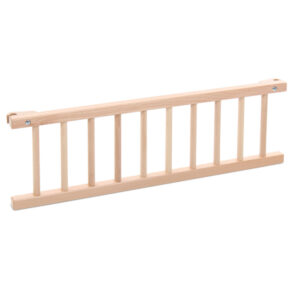 With a bedside sleeper conversion kit, you can easily transform your bedside co-sleeper into a standalone baby bassinet. One that you can gradually move across the room until your little one gets used to sleeping away from your side.
With a bedside sleeper conversion kit, you can easily transform your bedside co-sleeper into a standalone baby bassinet. One that you can gradually move across the room until your little one gets used to sleeping away from your side.
Before you know it, your baby will be sweetly exploring dreamland all night long. Even when you’re not right by their side.
The Real Key to Transitioning from Co-Sleeping to Crib: Be Consistent
You’ll hear this advice again and again, and for good reason: keeping consistent is the most important thing you can do to help baby feel confident and comfortable as they get used to their new nighttime routine.
Some experts recommend putting an “our bed is off limits” rule in place for the first three months after you’ve stopped co sleeping. This means that your baby is not invited onto their mattress at all—even for nap times or cuddling—until they’ve had enough time to adjust to sleeping in a space all their own.
It makes sense that many parents find this an effective tactic to stop co-sleeping. Your baby is still too young to logically understand why cuddling at 10am is totally fine, but sleeping by your side at night is off-limits.

Keeping your baby completely away from your bed until they have fully adjusted to their new nighttime routine can help deliver sounder nights of comfortable and confident sleep for them. And sounds nights of sleep for you!
Of course, if you’ve been co sleeping with the help of a bedside co-sleeper, then your baby is likely well-prepared to take on the challenge of adjusting to a new sleeping space.
Because they’re already used to being comfy and cozy on a mattress all their own, they won’t have as much trouble leaving your bedside behind. (Especially if you’re simply transforming your trusted bedside sleeper into a baby bassinet that baby gets to continue to happily sleep on all night long!)
Which means when it’s time to figure out how to transition from co-sleeping to crib, you can be confident that your baby is well-prepared for the journey ahead.
Safely co-sleeping with your newborn doesn’t start in the moment you down with them in your shared room set-up…it starts well before that moment.
Because setting up your room for safe and comfortable co-sleeping is the easiest way for you to get more hours of rest during the night. While feeling the satisfied peace of mind that comes from knowing your baby is lovingly and sweetly snoozing beside you.
Some parents begin their transition to co-sleeping by researching safe co sleeping positions and getting excited for the many co-sleeping benefits they can expect to enjoy in the days ahead. (Ones like an easier nighttime nursing routine and deeper bonding between you and baby, just to name a few!). 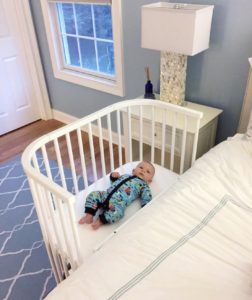
These can be helpful places to begin your co sleeping journey. But once you’re really ready to take the next steps in learning how to safely co-sleep with newborn, thinking through the specifics of your baby’s soon-to-be sleeping environment is the peace of mind-delivering best next step.
There’s a good reason for that: While there are many ways to co-sleep, but not all of them will gift you with the sound nights of stress-free rest that you’re looking for.
So before you go all-in on co-sleeping with your little one, ask yourself 2 big questions. Ones that guarantee that you’ll soak up all the beautiful co-sleeping benefits that are available to you. While still guaranteeing that your safety remains top-notch.
What safe co-sleeping positions will work best considering my home setup?
Experts are in agreement: when your baby is first brought home, the safest place for them to sleep is close by your side. (That way you’ll be able to respond to every need with super-parent speed!)
But sleeping close by your side doesn’t necessarily mean sharing your bed.
Truth is, your baby’s body will not be properly supported by the super-soft mattress, plush comforters, and soft-as-a-cloud pillows you love.
Especially during the first months of their life, your baby needs a clean and firm sleep surface that will support them. Particularly as they spend long hours of the night laying on their back and catching some much-needed Zs.
While pillows and cozy comforters might be the bedding-of-choice for adults, your baby is quite skilled enough to unroll themselves from any tangled situation they might get into. Which means that all that softness should be saved for when they grow a little bit bigger.
Safe solutions like bedside co-sleepers offer your baby a way to be by your side while still getting the support they crave. They can rest on a made-just-for-them baby bed mattress that provides comfort and proper ventilation. While you rest easy while being surrounded by your comfiest blankets and silkiest sheets.
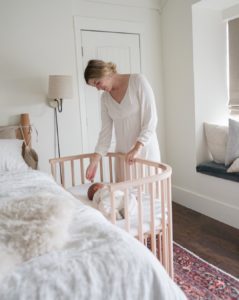
And though it might seem like bedside co sleepers that securely attach directly to your bed aren’t an option for families living in small spaces, compact co-sleeper models can naturally fit into any room. While still making it easy to turn your bedroom into a baby-loved co-sleeping space.
How do I create a healthy environment when sharing my bedroom with baby?
There are several best practices when it comes to sharing bedroom with baby that get said on repeat. Like how important it is to keep the room smoke-free and keep the temperature not too cool, not too hot.
And sure, you might feel like you’ve been there, researched that when it comes to those much-repeated best practices. But there is still one big every-parent-should-know safety concern that still comes as a surprise to most parents.
Here it is: your baby’s sleeping materials might not be as non-toxic as you think they are.
Most bedside co-sleepers, baby cribs, and baby bassinets on the market are full of toxic finishes, harmful chemicals, and damaging hard plastics that can wreak havoc on your baby’s still-developing body and immune system.
That’s why it’s so important to choose a bedside co-sleeper (and stash of baby products in general!) made of non-toxic, all-natural, eco-friendly wood and harm-free finishes.
And when it’s time to buy sheets and a mattress pad for your baby to sleep on, look for ones that provide proper ventilation while being made of chemical-free materials and baby-friendly cotton and polyester fabrics.
How to Safely Co Sleep With Newborn: The Benefits of a Bedside Co-Sleeper
For parents who are just starting to explore co-sleeping, it’s easy to feel like you’re desperately trying to fit all pieces of the co-sleeping puzzle into one, clearly-readable, easy-to-implement way for both you and baby to rest easy through the night.
And while many parents toss and turn with worry, wondering…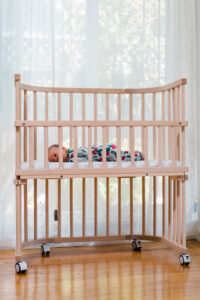
Have I perfectly designed my co sleeping space for baby to sleep easy?
Does baby have what they need to feel safe and supported as we sleep?
Have I chosen a safe co sleeping position that will help baby—and me!—rest stress-free all night long?
Having the right co-sleeping bed securely attached to your bedside can take all the guesswork out of how to safely co-sleep with newborn.
It can feel like a challenge to adapt your made-for-adults bedroom into a perfect-for-baby safe sleeping space.
But bedside co-sleepers make it possible for you to create the perfect safe co-sleeping space for your baby. Without needing to throw away your existing mattress or sheets. Redesign your own bedroom space. Or spend a single minute of much-needed sleep time wondering whether baby is feeling nurtured and supported in the way they need.
Sounds like a dream, doesn’t it?
Whether you’re welcoming your first little one into the world or have plenty of practice co-sleeping with newborns: getting a full night of rest is probably at the top of your priority list. Luckily, it’s pretty easy to take the guesswork out of how to co-sleep with an infant in the perfect sleep set-up. One that will deliver you total peace of mind while delivering your little one a full night of Z’s.
Let’s start with the most basic: while some co-sleeping methods (like bed-sharing) are likely to leave you tossing and turning with worry for baby’s safety, a safe bedside co-sleeper helps you sleep soundly — while baby catches plenty of Z’s of their own!
Let’s break down all the reasons why bedside co-sleepers are the no-brainer way that parents support their own rest. While leaving your little one resting peacefully all night long.
Here are 4 ways that bedside co-sleepers help you and baby get the quality sleep with an infant you crave:
1. Bedside co-sleepers make nighttime nursing easy-as-can-be
You can expect your baby to double their weight in the first five months of their life. All that growing takes a lot of energy!
Combine that need for a nutrient boost with a tiny tummy that can only take in a little milk at a time. And what do you have?
Answer: the perfect formula for frequent feedings through the night.
For parents who choose a detached crib or baby bassinet, those frequent feedings will mean constantly pushing back the covers, getting out of bed, leaning down into a crib, and trying to find a position that will let baby feed…without you feeling uncomfortable.
And though your body and mind will both be ready to get some rest once baby is fed and you’re back in bed, getting comfy in your pillows and blankets again is going to take some time.
With bedside co-sleepers, baby is always within reach.
That means you’ll be easily able to give baby what they need without taking long walks across the room. (Because trust us—those extra steps add up fast!) And without moving from the comfortable space of your own bed to find a space to breastfeed baby elsewhere.
Which is good news! Because the less disrupted your sleep feels, the easier it will be to fall right back into dreamland.
2. Bedside co-sleepers help you quickly care for every concern while co-sleeping with an infant
Hunger isn’t the only reason your baby might cry during the night.
They might not love the temperature of the room. Or could be trying to let you know that a soiled diaper is causing them discomfort.
They might even just be calling out for a little extra love.
Being within arm’s reach of your baby helps you quickly — and easily! — take stock of what baby needs. In fact, you won’t even have to leave the comfort of the covers when caring for baby’s cries. Which won’t just help you get more shut-eye during the night. It will also help your body’s regulate in a healthy way.
In fact, researchers have found that your baby’s body deeply senses your closeness.
When you co-sleep with infant, your little one’s body temperature naturally (and healthily) raises slightly, while they also use energy more efficiently and breathe more regularly.
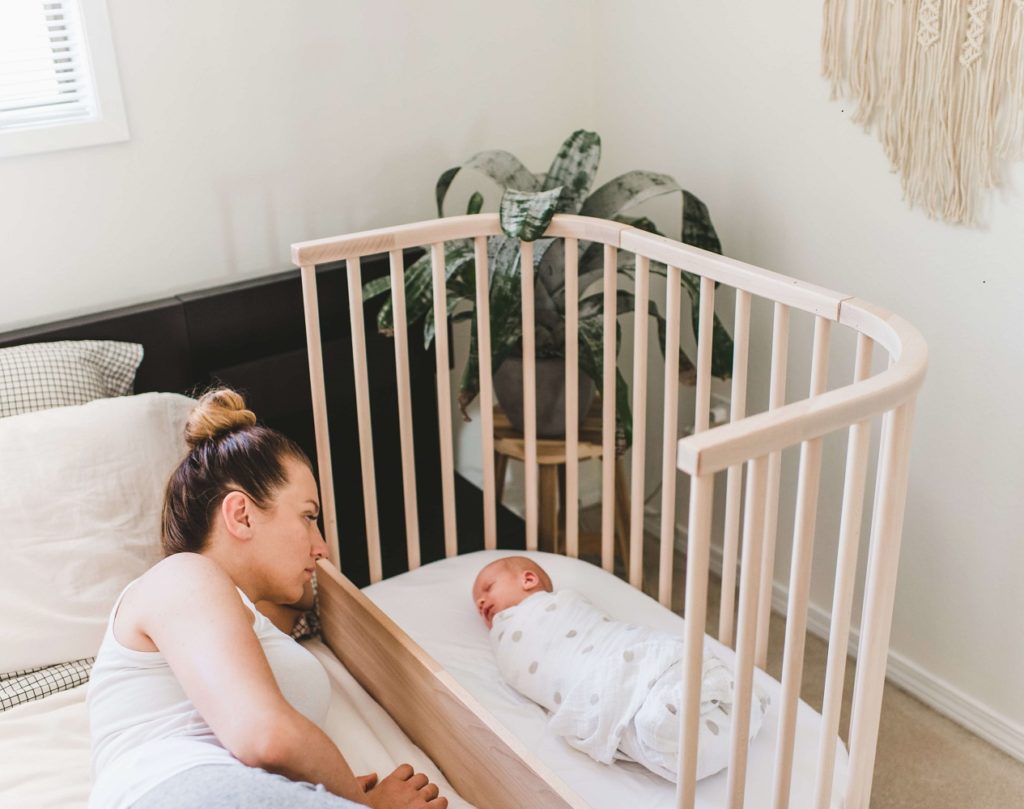
3. Bedside co-sleepers make it easier to co-sleep with twins and multiples
For families with twins or multiple newborns, the question isn’t how to co-sleep with an infant and wake up well-rested. The question is how to co-sleep with infants and get any rest at all.
And while some parents quickly decide to give each baby a crib or baby bassinet of their own, this adds time and distance during every feeding or crisis call.
But a bedside co-sleeper for twins can support both babies in safe comfort. Without you needing to get up or push off your covers to care for their needs.
When your babies are in a bedside co-sleeper for twins, their bodies and minds feel the impact.
Experts believe that when twins sleep together, they’re reminded of the nurturing feeling of sharing a womb. This gives their healthy growth a boost while helping synchronize their feeding and wake-up patterns during the night.
That synchronization is key. Because the more in sync your babies become, the fewer times you’ll be called to care for them—leading to far more sleep for you!
4. Bedside co-sleepers set your mind at peace
When baby isn’t close by, it’s easy to be filled with thoughts of what might be going wrong.
But bedside co-sleepers make it easy to check that baby is sleeping safe and sound.
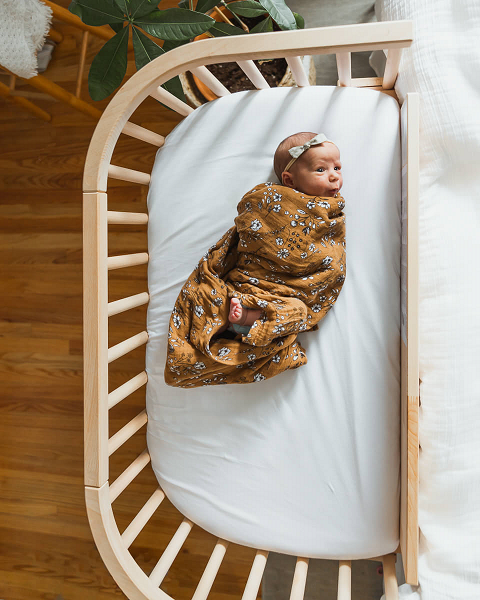
That means you’ll spend less time wondering and worrying about how baby is doing—and more time getting the sleep you need.
babybay bedside co-sleepers are committed to making peace of mind a priority.
That’s why every babybay bedside sleeper is made of locally-sourced and eco-friendly beechwood that is naturally antibacterial and antistatic. babybay bedside co-sleepers are also free of the toxic wood glues, cheap fillers, plastics, or other harmful chemicals that fill most other cribs, baby bassinets, and bedside co-sleepers.
Because for most parents, figuring out how to co-sleep with infant and wake up well-rested can be a challenge.
But babybay believes that better rest is possible—and is committed to delivering nights full of sweet, sound, and long rest to families like yours.
[Choose your babybay]
Between frequent feedings, diaper changes, and nurturing baby through every fuss — getting a full night of sound rest can be a challenge for any family with a newborn. But for families with twins or multiple newborns (which is what we assume you are, if you’re on this page wanting to figure out the secrets behind how to co-sleep with twins!), getting enough shuteye during the night to care for your babies and tackle all the to-dos of the day can sometimes feel less like a challenge…and more like an impossible-to-achieve dream.
But luckily, twins don’t have to mean the end of your co-sleeping dreams. Because there are ways to co-sleep with twins soundly, safely, and comfortably, while taking away all the stress and second-guessing about how to make your night routine go smoothly.
In fact, co-sleeping makes it easier (not harder) for families with twins to get restful nights of sleep. You just need the right safe sleep tools and how-to help in your back pocket.
Why Co-Sleeping with Twins Makes Your Nighttime Routine Easier
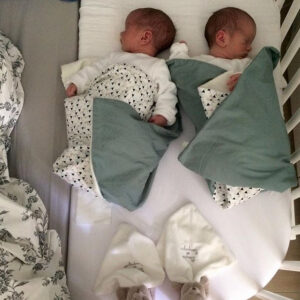
When your baby is first born, they need a lot of milk to grow big and strong.
But they also have a very tiny tummy, which means the adult-loved method of getting three meals a day just won’t cut it.
Though every baby is a little different, you can expect your little ones to feed every 1-3 hours during their first days and 2-4 hours during their first months.
When it comes to twins, you can expect to multiply that feeding schedule times two.
And while other newborn twins sleeping arrangements will require you to get out of bed every time a nighttime feeding call comes and reach over crib bars to give your babies what they need (a walk and reach-down that isn’t too bad the first time around, but can feel much longer and more comfortable the more times it has to be done), co-sleeping lets you care for your little ones without even getting out of bed.
With the right bedside sleeper for twins securely attached to your bedside, you’ll be able to nurse and nurture both of your babies without needing to get up, make frequent trips across the room, or uncomfortably reach down into a more traditional crib or bassinet.
And you can do it all without worrying about whether your set-up is safe, because you’ll know they have a made-just-for-them sleep space that is expertly-engineered to provide for their comfort while delivering all the benefits — for both you and them — that co-sleeping brings.
Good news, right? Here’s the even better news: according to the University of Notre Dame’s Mother-Baby Behavioral Sleep Laboratory, sleeping close to your babies offers necessary physiological regulation and support.
That means sleeping close doesn’t just make things easier for you, but offers your babies the sensorial stimuli they need for healthy emotional development and better resilience in body and mind (among many other co-sleeping benefits!).
What is Co-Bedding and Why Is It Often Considered the Best Sleeping Position for Twins?
Though co-bedding and bed sharing are sometimes used interchangeably, when it comes to twins or multiples, they mean something very different.
 In the context of twins, co-bedding refers to the practice of letting multiple babies of very similar ages share a sleeping space such as a bedside co sleeper, a twin crib, or a twin baby bassinet.
In the context of twins, co-bedding refers to the practice of letting multiple babies of very similar ages share a sleeping space such as a bedside co sleeper, a twin crib, or a twin baby bassinet.
Experts are increasingly celebrating co-bedding as a way to mimic the nurturing feeling that twins experience when they’re together in the womb, which provides them with comfort and settles their emotional and physical systems.
In a clinical study carried out by Dr. Helen Ball (Director of the Durham Infancy & Sleep Center), babies who slept together through the night were able to enjoy greater sleep pattern synchronicity.
That means that twins who sleep together are more likely to sleep at the same time — and wake up at the same time too!
So instead of waking up to care for one baby, going back to sleep, and then being called awake again to care for your other baby who needs attention, you’ll be able to meet both of your babies’ needs at once (and spend all that saved time getting some much-needed shut-eye!).
Co-Sleeping with Twins: What are the Best Newborn Twins Sleeping Arrangements?
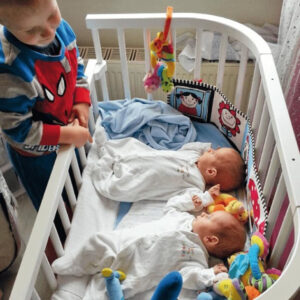
Though some parents wonder whether encouraging their babies to sleep in the same space will lead to restless sleeping patterns between the two or awkward positioning that can get in the way of their sound sleep, all the research suggests that twins sleep better (not more restlessly!) when they’re together.
And when it comes to helping twins or multiples co sleep soundly, there’s no best practice when it comes to positioning.
Though most twins sleep side-by-side for the first month, you should feel free to let your twins shift to head-to-head, feet-to-feet, or side-by-side diagonal without concern.
No matter what twin co sleeping position you choose, research has proven that all twin co-sleeping positions are equally safe, comfortable for your babies, and supportive of long and restful sleep.
How to Co-Sleep with Twins (The Easy Way!)
With a bedside co-sleeper, co-sleeping with twins becomes even easier.
Like all babybay bedside co-sleepers, the babybay Maxi Tall is designed to give your babies a made-just-for-them sleeping space to feel supported and nurtured all through the night.
With one “such good news!” catch — it’s specifically built to support twins. 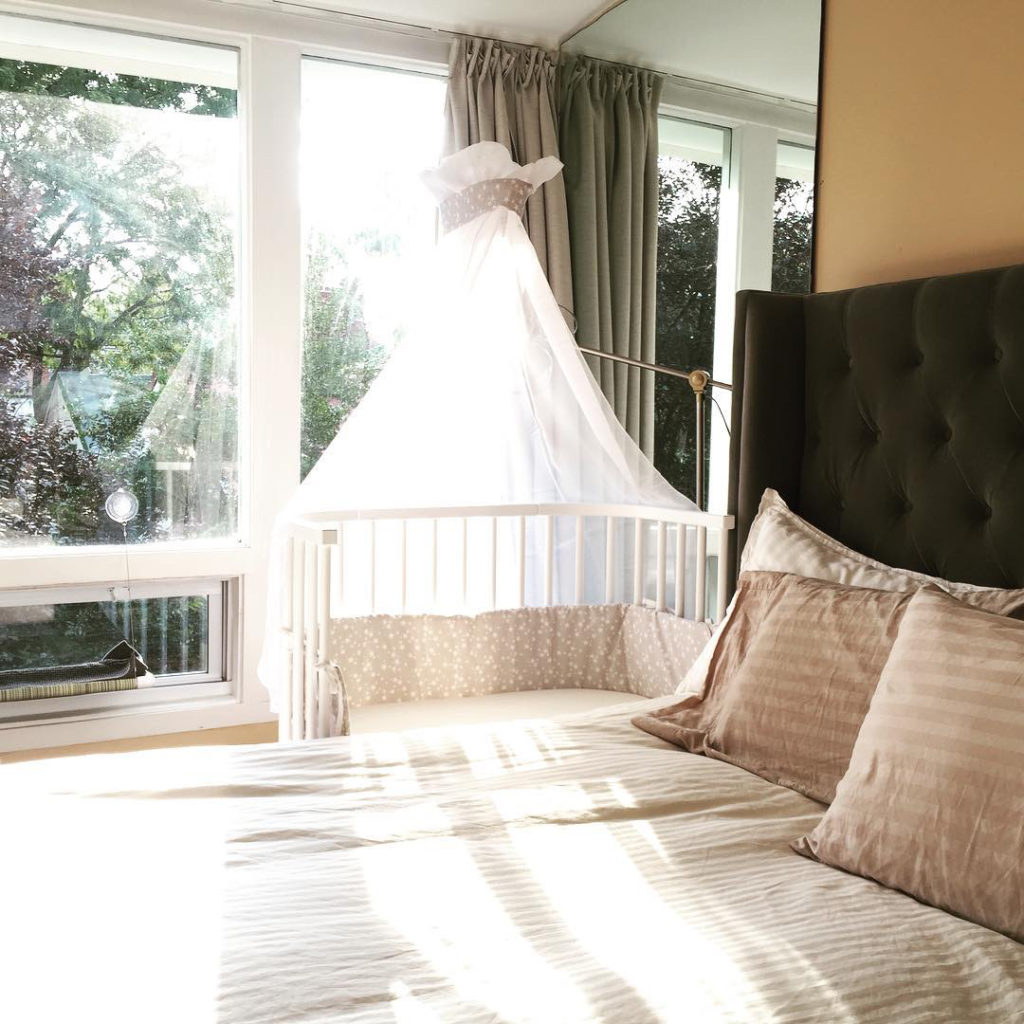
And unlike most bedside co-sleepers and cribs out on the market, your babybay is made with 100% eco-friendly, durable, and sustainably-sourced beechwood (and free of all the toxic chemicals, glues, and polishes that you’ll find in most cribs and bedside sleepers).
With the babybay Maxi Tall securely attached to your bed, your baby will stay snug while you gently watch over them from just an arm’s reach away. This bedside co-sleeper is also specially designed to provide your babies the extra wiggle room they need to sleep soundly together — without fighting for space or feeling cramped.
And any time you decide that a twin crib or bassinet for twins will fit your family’s needs better, you can easily convert your babybay Maxi Tall into a standalone baby bassinet. (So that you have plenty of ways to support your babies’ growth and sound sleep as you co-sleep with twins!)
How to start, when to stop co-sleeping: every co-sleeping family will have a slightly different journey. That’s because every family is unique, and so is every family’s needs.
But no matter the ins-and-outs of your family’s uniqueness, most people start here: when your baby first comes home, the ideal place for them to sleep soundly is by your side in a bedside co-sleeper or other safe sleep tool specially designed to keep them safe, secure, and enveloped in a hug of love all through the night.
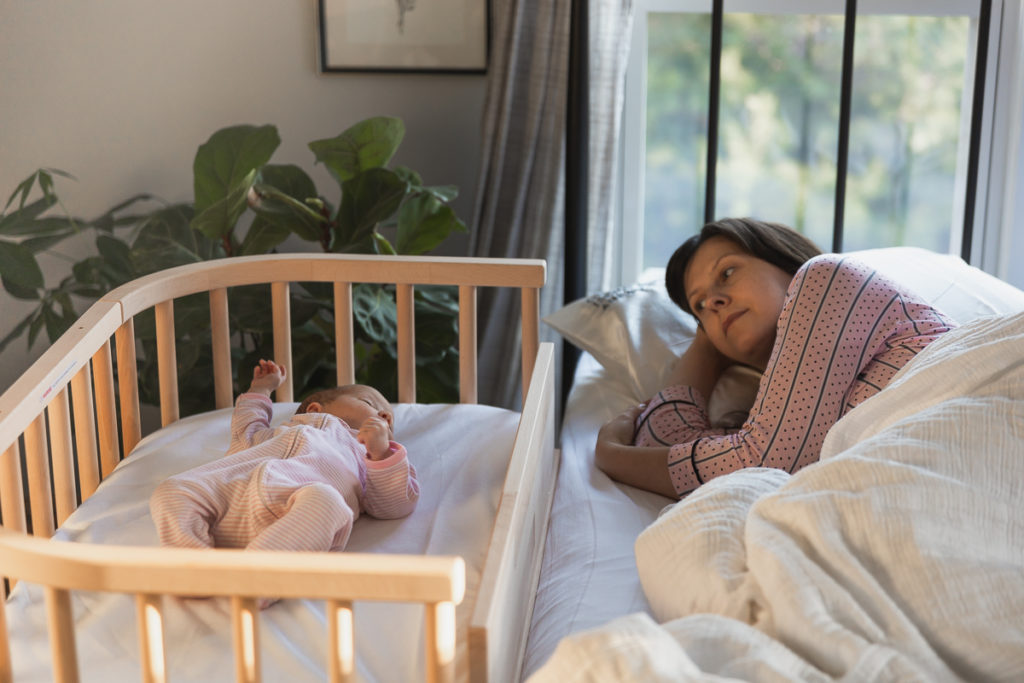
(Why is a safe sleep tool like a bedside sleeper preferred? Because too-soft bedding can pose risks when your baby hasn’t quite hit the developmental milestones to easily roll out of it yet.)
But over the next few months, your baby will grow from a newborn into a crawling, playing, keep-you-on-your-toes toddler. And when that time comes, you may begin thinking about the best age to transition from co-sleeping with your family’s own special timeline in mind.
How Your Co-Sleeping Family’s Journey Will Be Unique
Every baby is unique, and so is every co-sleeping family. That means that every co-sleeping journey will look a little different.
But no matter your family’s special co-sleeping timeline, it can be helpful to check in at different milestones during your baby’s first few months to stay aware of both baby’s development (as well as your family’s needs).
Checking in during these early months can help you make decisions about the best age to transition from co-sleeping down the road. (Even if that time still feels far, far off for you right now!)
No matter when you decide to stop co-sleeping, the good news is that co-sleeping with your baby during their early life has left them well-prepared to take on sleeping (and the world, while they’re at it!) all on their own.
Co-sleeping helps your baby develop sensory awareness, meaning that they’ll easily be able to tell the difference between comfort or crisis and rest—or call for your help—accordingly.

Your baby has also had plenty of time to nurture a deep and meaningful relationship with you, which means they will feel surrounded and supported by your love even if you’re sleeping farther than an arm’s length away.
This means when the time to transition from co-sleeping comes, you and baby will be more than ready to tackle all the nights of snoozes and sweet dreams ahead.
When to Stop Co-Sleeping: The 5 Month Milestone
Baby’s first few months set the stage for a lifetime of healthy growth.
That’s why co-sleeping during this part of baby’s life is such an important tool in their grow-big-and-strong toolkit.
By catching their first few months of z’s in a designed-just-for-them bedside co-sleeper that fits flush against your bed (meaning you’re always close by!), baby will benefit from a boosted immune system and better supported emotional and physical development.
That’s why it’s important to take full advantage of all the co-sleeping benefits your bedside co-sleeper can offer in these early months of baby’s life.
Though Europe tests and endorses bedside co-sleepers through baby’s first year, the United States has yet to expand their testing and endorsement procedures past five months of age.
However, experts agree that sleeping close to your baby is still best practice through the first year of their life.
That means around five months might be the right time to start taking stock of how baby has grown and decide whether it might be time to start transitioning your baby into a crib or convert your co-sleeper into a bedside bassinet or whether they’re still comfy-as-can-be where they are.
When to Stop Co-Sleeping: The 9 Month Milestone
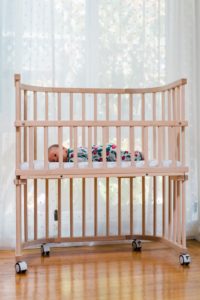
When it comes time to fully decide when to stop co-sleeping, developmental stages and family needs are more important indicators than age.
That’s because all babies are unique, and their growth stages are going to be just as unique as they are.
Likewise, no two families are the same. What works well for one family might cause nights of restless tossing and turning for another.
It’s a good idea to check in with your baby at the 9 month milestone to make sure that co-sleeping is still the best sleeping solution for them (and you!).
If baby has started feeling confident enough in their mobility to move from the safe space of their bedside co-sleeper into the maze of blankets and pillows that you keep on your own bed, it might be time to think about keeping baby more secure with a standalone baby bassinet or crib.
Those blankets and pillows you love to curl up in and keep close can quickly become a safety hazard to baby. Though baby might be learning to be a confident crawler at this age, they still haven’t quite figured out the art of being an escape artist.
(Ready to learn more about how to co-sleep safely? We’ve got you covered!)
And when it comes to plush bedding that can easily wrap around them or cover their head, those escape artist skills are much-needed to assure fully safe sleeping throughout the night.
But remember: at the end of the day, only you know the co-sleeping timeline that works best for your family.
The Big Takeaway
The day when it’s time to stop co-sleeping with baby will come.

But when it does, be excited to walk with baby toward their next milestone!
Because baby has been co-sleeping all life long, their body and mind are ready to take full advantage of all the developmental benefits and conquer every new adventure that comes their way during nights ahead.
And just because baby is ready to transition their bedside co sleeper into a bedside bassinet or sleep in a crib all their own doesn’t mean they have to go far.
If you choose to stop co-sleeping around one of these early milestones, you can still help support baby’s next stage of sleep by positioning their baby bassinet or bedside crib right against your bed, or moving it no more than a step or two away from your own mattress.

That way, baby will still be able to feel your loving presence offering comfort from close by, even as they adjust to the feeling of sleeping in this new space that is fully their own.
As baby becomes more comfortable in their bedside bassinet or crib (and as space in your bedroom allows), you can slowly move baby’s sleeping space farther and farther from your own bed. This will help baby gradually develop confidence and awareness that you’re nearby to help, even when you’ve stopped co-sleeping and are farther than an arm’s length or two away.
And on the day you decide it’s finally time to stop wondering when to stop co-sleeping and start really moving your baby to a crib and room of their own: just know they’ll feel well-prepped for this next important step.



